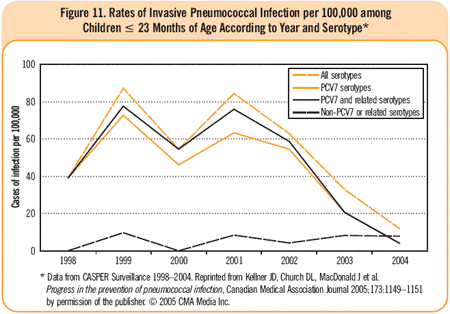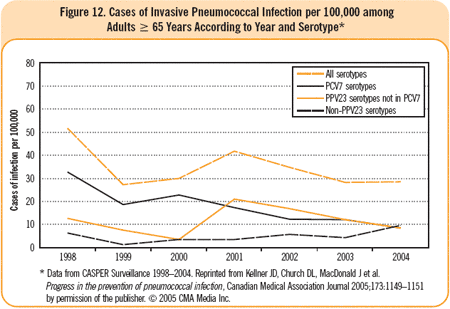Common menu bar links
Institutional links
Diseases & Conditions
Health & Safety
Research & Statistics
Agency Information
Search Box
E-mail this page
Vaccine-Preventable Diseases
Pneumococcal
Streptococcus pneumoniae (pneumococcus) is the leading cause of bacteremia, meningitis, bacterial pneumonia and acute otitis media (AOM) in children. Invasive pneumococcal disease (IPD) is most common in the very young, the elderly and certain specific groups at high risk, such as individuals with functional or anatomic asplenia and congenital or acquired immune deficiency, including those with acquired immune deficiency syndrome (AIDS).
Epidemiology
IPD has been nationally notifiable since 2000. Age-specific incidence rates (per 100,000 population per year) during the period 2000 to 2004 were 39.8 among infants < 1 year of age, 24.6 among children 1 to 4 years, and 13.3 among adults ≥ 60 years. Children < 1 year of age accounted for 7% of cases (mean 130 cases per year), those aged 1 to 4 years accounted for 18% (mean 345 cases per year), and adults ≥ 60 years accounted for 37% (mean 711 cases per year) of Canadian IPD cases.
The serotypes contained in the 7-valent vaccine consist of serotypes circulating during the pre-vaccine era in Canada, as follows: > 80% of serotypes isolated from the blood or cerebrospinal fluid (CSF) of children, 95% of serotypes isolated with high level penicillin resistance, and 73% of those isolated with intermediate level resistance. There may be populations or communities, such as Aboriginal children in northern communities, with a different distribution of serotypes.
In northern Canadian regions participating in the International Circumpolar Surveillance project between 1999 and 2004 (i.e., Yukon, Northwest Territories, Nunavut and northern regions of Quebec and Labrador), 62.5% of IPD isolates from children < 2 years of age were serotypes contained in the 7-valent vaccine. Among persons ≥ 65 years of age, 86.4% of isolates obtained were serotypes contained in the 23-valent vaccine. In Nunavut and Northern Quebec, the two regions with universal conjugate programs in place during 2002, there were 19 cases of preventable IPD (i.e., caused by the seven serotypes in the vaccine) among children < 2 years before program implementation (1999-2002) and none after (2003-2004).
The introduction of universal pneumococcal conjugate immunization for infants in the Calgary region of Alberta, in September 2002 led to a prompt and large decline in the incidence of IPD among children < 2 years of age (Figure 11). There has also been a decline in the incidence of IPD caused by the seven serotypes contained in the conjugate vaccine among adults ≥ 65 years (See Figure 12). As in the United States, the magnitude of the decline among older people is likely due to the indirect effect of conjugate vaccine rather than a direct effect of polysaccharide vaccine, because the reduction among adults ≥ 65 years was only for infections caused by serotypes contained in the conjugate vaccine and was larger than any reduction expected from the use of polysaccharide vaccine.
Source: Canadian Immunization Guide, 7th edition, 2006
Links to more information
Guidelines and Recommendations
- For information about Pneumococcal vaccine, see the Canadian Immunization Guide, 7th edition 2006
Information Sheets
Additional Resources


